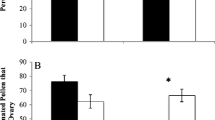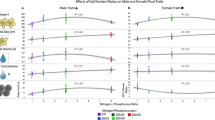Abstract
Aims
Metal hyperaccumulation by plants involves the uptake and sequestration of extremely high concentrations of soil heavy metals. It is unclear, however, whether plants that hyperaccumulate heavy metals do so across all organs, including reproductive ones, and whether floral metal accumulation varies depending on whether plants require pollinator visitation for reproduction.
Methods
We grew two species of nickel hyperaccumulators, one that requires pollinator visitation and the other an autonomous selfer, in two soil treatments: (1) control or (2) nickel-supplemented. We quantified nickel concentration in leaves, reproductive organs and floral rewards (pistils, anthers, pollen and nectar).
Results
Nickel accumulated into all organs, with the autonomously selfing species (Noccaea fendleri subsp. glauca) accumulating higher concentrations, especially in anthers and pistils. Streptanthus polygaloides incorporated nickel into nectar, but at lower concentrations than floral organs. Both species incorporated nickel into pollen.
Conclusions
Nickel-hyperaccumulators incorporated nickel into all reproductive organs as well as rewards, suggesting possible reproductive consequences that may either be positive (e.g., elemental defense) or detrimental (e.g., reducing gamete viability or pollinator visitation) to plant fitness. Our work suggests that identifying any adaptive value of metal hyperaccumulation requires further study of floral metal accumulation and the reproductive consequences of metals in reproductive organs and rewards.

Similar content being viewed by others
References
Adamidis GC, Aloupi M, Kazakou E, Dimitrakopoulos PG (2014) Intra-specific variation in Ni tolerance, accumulation and translocation in the Ni-hyperaccumulator Alyssum lesbiacum. Chemosphere 95:496–502. doi:10.1016/j.chemosphere.2013.09.106
Adler LS (2000) The ecological significance of toxic nectar. Oikos 91:409–420. doi:10.1034/j.1600-0706.2000.910301.x
Adler LS, Irwin RE (2005) Ecological costs and benefits of defenses in nectar. Ecol 85:2968–2978. doi:10.1890/05-0118
Al-Shehbaz IA (2013) Brassicaceae. In: Flora of North America Editorial Committee, eds. 1993+. Flora of North America north of Mexico. 16+ vols. New York and Oxford
Arceo-Gómez G, Ashman TL (2014) Coflowering community context influences female fitness and alters the adaptive value of flower longevity in Mimulus guttatus. Am Nat 183:E50–E63. doi:10.1086/674358
Baker I (1979) Methods for the determination of volumes and sugar concentrations from nectar spots on paper. Phytochem Bull 12:40–42
Baldwin BG, Goldman DH, Keil DJ, Patterson R, Rosatti TJ, Wilken DH (eds) (2012) The Jepson manual: vascular plants of California. University of California Press, Berkeley
Boyd RS, Martens S (1992) The raison d’etre for metal hyperaccumulation by plants. In: Baker AJM, Proctor J, Reeves RD (eds) The vegetation of ultramafic (serpentine) soils. Intercept, Andover, pp 279–289
Boyd RS, Shaw JJ, Martens SN (1994a) Nickel hyperaccumulation defends Streptanthus polygaloides (Brassicaceae) against pathogens. Am J Bot 81:294–300. doi:10.2307/2445455
Boyd RS, Shaw JJ, Martens SN (1994b) Nickel hyperaccumulated by Thlaspi montanum var. montanum is acutely toxic to an insect herbivore. Oikos 70:21–25
Boyd RS, Wall MA, Santos SR, Davis MA (2009) Variation in morphology and elemental concentrations in the California nickel hyperaccumulator Streptanthus polygaloides (Brassicaceae). Northeast Nat 16:21–38. doi:10.1656/045.016.0503
Brooks RR (1998) Phytochemistry of hyperaccumulators. In: Brooks RR (ed) Plants that hyperaccumulate heavy metals. CAB International, New York, pp 15–53
Brown PD, Tokuhisa JG, Reichelt M, Gershenzon J (2003) Variation of glucosinolate accumulation among different organs and developmental stages of Arabidopsis thaliana. Phytochemistry 62:471–481. doi: 10.1016/S0031-9422(02)00549-6
Echevarria G, Massoura ST, Sterckeman T, Becquer T, Schwartz C, Morel JL (2006) Assessment and control of the bioavailability of nickel in soils. Environ Toxicol Chem 25:643–651. doi:10.1897/05-051R.1
Ghasemi R, Chavoshi ZZ, Boyd RS, Rajakaruna N (2014) A preliminary study of the role of nickel in enhancing flowering of the nickel hyperaccumulating plant Alyssum inflatum Nyár. (Brassicaceae). S Afr J Bot 92:47–52. doi:10.1016/j.sajb.2014.01.015
Hladun KR, Parker DR, Tran KD, Trumble JT (2013) Effects of selenium accumulation on phytotoxicity, herbivory, and pollination ecology in radish (Raphanus sativus L.). Environ Pollut 172:70–75. doi:10.1016/j.envpol.2012.08.009
Jhee EM, Boyd RS, Eubanks MD (2005) Nickel hyperaccumulation as an elemental defense of Streptanthus polygaloides (Brassicaceae): influence of herbivore feeding mode. New Phytol 168:331–344. doi:10.1111/j.1469-8137.2005.01504.x
Kearns CA, Inouye DW (1993) Techniques for pollination biologists. University Press of Colorado, Niwot
L’Huillier L, Edighoffer S (1996) Extractability of nickel and its concentration in cultivated plants in Ni rich ultramafic soils of New Caledonia. Plant Soil 186:255–264. doi:10.1007/BF02415521
Littell RC, Stroup WW, Freund RJ (2002) SAS for linear models. SAS Institute, Cary
Malan HL, Farrant JM (1998) Effects of the metal pollutants cadmium and nickel on soybean seed development. Seed Sci Res 8:445–453. doi:10.1017/S0960258500004414
Marschner P (2012) Mineral nutrition of higher plants, 3rd edn. Academic, San Diego
Meindl GA, Ashman T-L (2013) The effects of aluminum and nickel in nectar on the foraging behavior of bumblebees. Environ Poll 177:78–81. doi:10.1016/j.envpol.2013.02.017
Meindl GA, Ashman T-L (2014) Nickel accumulation by Streptanthus polygaloides (Brassicaceae) reduces floral visitation rate. J Chem Ecol 40:128–135. doi:10.1007/s10886-014-0380-x
Meindl GA, Bain DJ, Ashman T-L (2014) Nickel accumulation in leaves, floral organs and rewards varies by serpentine soil affinity. AoB Plants. doi:10.1093/aobpla/plu036
Mohsenzadeh F, Chehregani A, Yousefi N (2011) Effect of the heavy metals on developmental stages of ovule, pollen, and root proteins in Reseda lutea L. (Resedaceae). Biol Trace Elem Res 143:1777–1788. doi:10.1007/s12011-011-9009-x
Moroń D, Grześ IM, Skórka P, Szentgyörgyi H, Laskowski R, Potts SG, Woyciechowski M (2012) Abundance and diversity of wild bees along gradients of heavy metal pollution. J Appl Ecol 49:118–125. doi:10.1111/j.1365-2664.2011.02079.x
Prins CN, Hantzis LJ, Quinn CF, Pilon-Smits EAH (2011) Effects of selenium accumulation on reproductive functions in Brassica juncea and Stanleya pinnata. J Exp Bot 62:5633–5640. doi:10.1093/jxb/err247
Psaras GK, Manetas Y (2001) Nickel localization of seeds in the metal hyperaccumulator Thlaspi pindicum Hausskn. Ann Bot 88:513–516. doi:10.1006/anbo.2001.1470
Quinn CF, Prins CN, Freeman JL, Gross AM, Hantzis LJ, Reynolds RJ, Yang S, Covey PA, Bañuelos GS, Pickering IJ, Fakra SC, Marcus MA, Arathi HS, Pilon-Smits EA (2011) Selenium accumulation in flowers and its effects on pollination. New Phytol 192:727–737. doi:10.1111/j.1469-8137.2011.03832.x
Rascio N, Navari-Izzo F (2011) Heavy metal hyperaccumulating plants: How and why do they do it? And what makes them so interesting? Plant Sci 180:169–181. doi:10.1016/j.plantsci.2010.08.016
Reeves RD (2006) Hyperaccumulation of trace elements by plants. In: Morel JL, Echevarria G, Goncharova N (eds) Phytoremediation of metal-contaminated soils. NATO Science Series: IV: earth and environmental sciences, vol 68. Springer, New York, pp 1–25
Reeves RD, Baker AJM (2000) Metal-accumulating plants. In: Raskin I, Ensley BD (eds) Phytoremediation of toxic metals: Using plants to clean up the environment. Wiley, New York, pp 193–229
Reeves RD, Macfarlane RM, Brooks RR (1983) Accumulation of nickel and zinc by western North American genera containing serpentine-tolerant species. Am J Bot 70:1297. doi:10.2307/2443420
Safford HD, Viers JH, Harrison SP (2005) Serpentine endemism in the California flora: a database of serpentine affinity. Madroño 52: 222–257. doi:10.3120/0024-9637(2005)52[222:SEITCF]2.0.CO;2
Sánchez-Mata D, de la Fuente V, Rufo L, Rodrígues N, Amilis R (2014) Localization of nickel in tissues of Streptanthus polygaloides Gray (Cruciferae) and endemic nickel hyperaccumulators from California. Biol Trace Elem Res 157:75–83. doi:10.1007/s12011-013-9868-4
SAS Insitute Inc. 2011. SAS/STAT 9.3 User’s Guide. SAS Institute Inc.
Valdez Barillas JR, Quinn CF, Freeman JL, Lindblom SD, Fakra SC, Marcus MA, Gilligan TM, Alford ER, Wangeline AL, Pilon-Smits EA (2012) Selenium distribution and speciation in the hyperaccumulator Astragalus bisulcatus and associated ecological partners. Plant Physiol 159:1834–1844. doi:10.1104/pp. 112.199307
van der Ent A, Baker AJM, Reeves RD, Pollard AJ, Schat H (2013) Hyperaccumulators of metal and metalloid trace elements: facts and fiction. Plant Soil 362:319–334. doi:10.1007/s11104-012-1287-3
Vogel-Mikuš K, Pongrac P, Kump P, Necemer M, Simcic J, Pelicon P, Budnar M, Povh B, Regvar M (2007) Localisation and quantification of elements within seeds of Cd/Zn hyperaccumulator Thlaspi praecox by micro-PIXE. Environ Poll 147:50-59. doi: 10.1016/j.envpol.2006.08.026 DOI:10.1016/j.envpol.2006.08.026#doilink
Wall MA, Boyd RS (2002) Nickel accumulation in serpentine arthropods from the Red Hills, California. Pan Pac Entomol 78:168–176
Yousefi N, Chehregani A, Malayeri B, Lorestani B, Cheraghi M (2011a) Investigating the effect of heavy metals on developmental stages of anther and pollen in Chenopodium botrys L. (Chenopodiaceae). Biol Trace Elem Res 140:368–376. doi:10.1007/s12011-010-8701-6
Yousefi N, Chehregani A, Malayeri B, Lorestani B, Cheraghi M (2011b) Effect of heavy metals on the developmental stages of ovule and seed proteins in Chenopodium botrys L. Chenopodiaceae. Biol Trace Elem Res 144:1142–1149. doi:10.1007/s12011-009-8386-x
Zapata TR, Arroyo MTK (1978) Plant reproductive ecology of a secondary deciduous tropical forest in Venezuela. Biotropica 10:221–230
Acknowledgments
K. DeHart and C. Murray assisted with plant organ/reward analysis, E. York and K. Schuller provided greenhouse assistance, G. Arceo-Gomez, M. Koski and the Ashman lab and two anonymous reviewers provided useful comments on the research and/or manuscript. This research was funded by a Botany In Action Fellowship from the Phipps Conservatory and Botanical Gardens, an Ivy McManus Diversity Fellowship (University of Pittsburgh) and an Andrew Mellon Predoctoral Fellowship (University of Pittsburgh) to GAM, NSF (EAR-IF 0948366) to DJB, and NSF (DEB 1020523, 1241006) to TLA.
Author information
Authors and Affiliations
Corresponding author
Additional information
Responsible Editor: Henk Schat..
Rights and permissions
About this article
Cite this article
Meindl, G.A., Bain, D.J. & Ashman, TL. Variation in nickel accumulation in leaves, reproductive organs and floral rewards in two hyperaccumulating Brassicaceae species. Plant Soil 383, 349–356 (2014). https://doi.org/10.1007/s11104-014-2184-8
Received:
Accepted:
Published:
Issue Date:
DOI: https://doi.org/10.1007/s11104-014-2184-8




